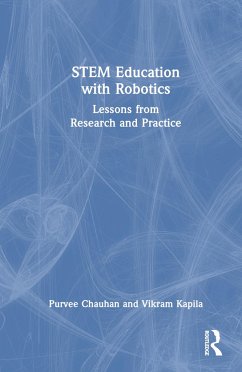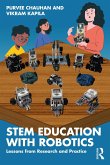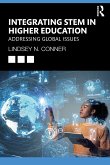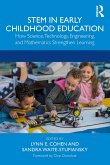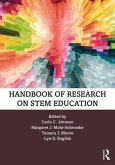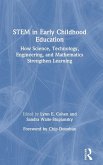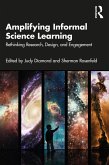- Gebundenes Buch
- Merkliste
- Auf die Merkliste
- Bewerten Bewerten
- Teilen
- Produkt teilen
- Produkterinnerung
- Produkterinnerung
This book offers a synthesis of research, curriculum examples, pedagogy models, and classroom recommendations for the effective use of robotics in STEM teaching and learning. Authors Chauhan and Kapila demonstrate how the use of educational robotics can improve and enhance student learning and understanding within the STEM disciplines.
Andere Kunden interessierten sich auch für
![STEM Education with Robotics STEM Education with Robotics]() Purvee ChauhanSTEM Education with Robotics45,99 €
Purvee ChauhanSTEM Education with Robotics45,99 €![Integrating STEM in Higher Education Integrating STEM in Higher Education]() Lindsey N. ConnerIntegrating STEM in Higher Education34,99 €
Lindsey N. ConnerIntegrating STEM in Higher Education34,99 €![STEM Education from Asia STEM Education from Asia]() STEM Education from Asia42,99 €
STEM Education from Asia42,99 €![STEM in Early Childhood Education STEM in Early Childhood Education]() STEM in Early Childhood Education42,99 €
STEM in Early Childhood Education42,99 €![Handbook of Research on STEM Education Handbook of Research on STEM Education]() Handbook of Research on STEM Education105,99 €
Handbook of Research on STEM Education105,99 €![STEM in Early Childhood Education STEM in Early Childhood Education]() STEM in Early Childhood Education195,99 €
STEM in Early Childhood Education195,99 €![Amplifying Informal Science Learning Amplifying Informal Science Learning]() Amplifying Informal Science Learning42,99 €
Amplifying Informal Science Learning42,99 €-
-
-
This book offers a synthesis of research, curriculum examples, pedagogy models, and classroom recommendations for the effective use of robotics in STEM teaching and learning. Authors Chauhan and Kapila demonstrate how the use of educational robotics can improve and enhance student learning and understanding within the STEM disciplines.
Hinweis: Dieser Artikel kann nur an eine deutsche Lieferadresse ausgeliefert werden.
Hinweis: Dieser Artikel kann nur an eine deutsche Lieferadresse ausgeliefert werden.
Produktdetails
- Produktdetails
- Verlag: Taylor & Francis Ltd
- Seitenzahl: 290
- Erscheinungstermin: 11. Mai 2023
- Englisch
- Abmessung: 235mm x 157mm x 20mm
- Gewicht: 522g
- ISBN-13: 9781032367569
- ISBN-10: 1032367563
- Artikelnr.: 67402256
- Herstellerkennzeichnung
- Libri GmbH
- Europaallee 1
- 36244 Bad Hersfeld
- gpsr@libri.de
- Verlag: Taylor & Francis Ltd
- Seitenzahl: 290
- Erscheinungstermin: 11. Mai 2023
- Englisch
- Abmessung: 235mm x 157mm x 20mm
- Gewicht: 522g
- ISBN-13: 9781032367569
- ISBN-10: 1032367563
- Artikelnr.: 67402256
- Herstellerkennzeichnung
- Libri GmbH
- Europaallee 1
- 36244 Bad Hersfeld
- gpsr@libri.de
Purvee Chauhan earned a Master's in Education degree from Harvard University, USA, with a focus on Technology and Innovation. She has 10 years of field-experience in the education sector, has held global impact positions in organizations such as New York University (NYU), Teach for India, and The Nalanda Project, and is currently an Instructional Designer at ASCD, one of the largest education non-profits in the United States. Vikram Kapila is a professor of mechanical and aerospace engineering at the NYU Tandon School of Engineering, USA, where he directs a Mechatronics, Controls, and Robotics Lab. His current research is focused on the convergence of frontier technologies (e.g., robotics, artificial intelligence, augmented/virtual reality, and blockchain) with applications to human-robot interaction, digital health, and STEM education.
Part I: Introduction. Chapter 1. Transformational Learning with Educational
Robotics. 1.1. Introduction. 1.2. STEM and technology-enhanced learning
environments. 1.3. Educational robotics. 1.4. Exhibiting the role of robots
in supporting student learning. 1.5. Conclusion. 1.6. Key takeaways.
Chapter 2. Applications of Robots in Educational Settings. 2.1.
Introduction. 2.2. Constructionism and educational robotics. 2.3.
Educational robotics: Roles and settings. 2.4. Examples of applications of
robots as a learning tool in teaching and learning. 2.5. Conclusion. 2.6.
Key takeaways. Chapter 3. Teaching STEM with Robotics: Synopsis of a
Research-guided Program. 3.1. Introduction. 3.2. Need for authentic STEM
learning experiences. 3.3. Rationale for robotics in STEM education. 3.4.
Overview, theoretical background, and project design. 3.5. Illustrative
examples from implementation. 3.6. Project outcomes and recommendations.
3.7. Conclusion. 3.8. Key takeaways. Part II: Theory, Design, and
Implementation. Chapter 4. Design-based Research for Robotics-enhanced
Learning Environments. 4.1. Introduction. 4.2. Design-based research. 4.3.
Literature review exemplifying the use of design-based research in
robotics-enabled learning. 4.4. Design-based research implementation
examples from robotics-enhanced learning environments. 4.5. Implementation
challenges of design-based research. 4.6. Conclusion. 4.7. Key takeaways.
Chapter 5. Effective Professional Development for Robotics-focused Learning
Environments. 5.1. Introduction. 5.2. Teacher professional development.
5.3. Designing for effective professional development. 5.4. Literature
review on teacher professional development for robotics-based learning.
5.5. Designing a robotics-based professional development program using
situated learning. 5.6. Creating a professional development program using
the social capital theory. 5.7. Challenges in planning effective
professional development programs and incorporating their lessons. 5.8.
Conclusion. 5.9. Key takeaways. Chapter 6. Applying TPACK to Design for
Robotics-enhanced Learning. 6.1. Introduction. 6.2. Technological,
pedagogical, and content knowledge. 6.3. Literature review on teachers'
TPACK development. 6.4. Development of teacher TPACK through professional
development aimed at using robotics as a learning tool. 6.5. Development of
TPACK-guided robotics-based STEM learning units. 6.6. Conclusion. 6.7. Key
takeaways. Part III: Instructional Perspectives and Lesson Designs. Chapter
7. Prerequisites, Practices, and Perceptions to Design Effective
Robotics-based Lessons. 7.1. Introduction. 7.2. Enabling effective
integration of robotics in classrooms. 7.3. Prerequisites for
robotics-based STEM lessons. 7.4. Instructional practices for effective
robotics-based lessons. 7.5. Factors that influence student perceptions of
utilizing robots as educational tools. 7.6. Conclusion. 7.7. Key takeaways.
Chapter 8. Applying Cognitive Domain of Bloom's Taxonomy to Robotics-based
Learning. 8.1. Introduction. 8.2. Bloom's taxonomy. 8.3. Literature review
on applications of Bloom's taxonomy in robotics. 8.4. Integrating cognitive
domain of Bloom's taxonomy with educational robotics to promote
higher-order thinking. 8.5. Conclusion. 8.6. Key takeaways. Chapter 9.
Using the 5E Instructional Model to Develop Robotics-based Science Units.
9.1. Introduction. 9.2. The 5E instructional model. 9.3. Literature review
on integrating the 5E model in robotics-based learning. 9.4. Exemplar
robotics-based science unit plans aligned with the 5E model and Next
Generation Science Standards. 9.5. Implementing the 5E instructional model.
9.6. Conclusion. 9.7. Key takeaways. Appendix A. Appendix B. Index
Robotics. 1.1. Introduction. 1.2. STEM and technology-enhanced learning
environments. 1.3. Educational robotics. 1.4. Exhibiting the role of robots
in supporting student learning. 1.5. Conclusion. 1.6. Key takeaways.
Chapter 2. Applications of Robots in Educational Settings. 2.1.
Introduction. 2.2. Constructionism and educational robotics. 2.3.
Educational robotics: Roles and settings. 2.4. Examples of applications of
robots as a learning tool in teaching and learning. 2.5. Conclusion. 2.6.
Key takeaways. Chapter 3. Teaching STEM with Robotics: Synopsis of a
Research-guided Program. 3.1. Introduction. 3.2. Need for authentic STEM
learning experiences. 3.3. Rationale for robotics in STEM education. 3.4.
Overview, theoretical background, and project design. 3.5. Illustrative
examples from implementation. 3.6. Project outcomes and recommendations.
3.7. Conclusion. 3.8. Key takeaways. Part II: Theory, Design, and
Implementation. Chapter 4. Design-based Research for Robotics-enhanced
Learning Environments. 4.1. Introduction. 4.2. Design-based research. 4.3.
Literature review exemplifying the use of design-based research in
robotics-enabled learning. 4.4. Design-based research implementation
examples from robotics-enhanced learning environments. 4.5. Implementation
challenges of design-based research. 4.6. Conclusion. 4.7. Key takeaways.
Chapter 5. Effective Professional Development for Robotics-focused Learning
Environments. 5.1. Introduction. 5.2. Teacher professional development.
5.3. Designing for effective professional development. 5.4. Literature
review on teacher professional development for robotics-based learning.
5.5. Designing a robotics-based professional development program using
situated learning. 5.6. Creating a professional development program using
the social capital theory. 5.7. Challenges in planning effective
professional development programs and incorporating their lessons. 5.8.
Conclusion. 5.9. Key takeaways. Chapter 6. Applying TPACK to Design for
Robotics-enhanced Learning. 6.1. Introduction. 6.2. Technological,
pedagogical, and content knowledge. 6.3. Literature review on teachers'
TPACK development. 6.4. Development of teacher TPACK through professional
development aimed at using robotics as a learning tool. 6.5. Development of
TPACK-guided robotics-based STEM learning units. 6.6. Conclusion. 6.7. Key
takeaways. Part III: Instructional Perspectives and Lesson Designs. Chapter
7. Prerequisites, Practices, and Perceptions to Design Effective
Robotics-based Lessons. 7.1. Introduction. 7.2. Enabling effective
integration of robotics in classrooms. 7.3. Prerequisites for
robotics-based STEM lessons. 7.4. Instructional practices for effective
robotics-based lessons. 7.5. Factors that influence student perceptions of
utilizing robots as educational tools. 7.6. Conclusion. 7.7. Key takeaways.
Chapter 8. Applying Cognitive Domain of Bloom's Taxonomy to Robotics-based
Learning. 8.1. Introduction. 8.2. Bloom's taxonomy. 8.3. Literature review
on applications of Bloom's taxonomy in robotics. 8.4. Integrating cognitive
domain of Bloom's taxonomy with educational robotics to promote
higher-order thinking. 8.5. Conclusion. 8.6. Key takeaways. Chapter 9.
Using the 5E Instructional Model to Develop Robotics-based Science Units.
9.1. Introduction. 9.2. The 5E instructional model. 9.3. Literature review
on integrating the 5E model in robotics-based learning. 9.4. Exemplar
robotics-based science unit plans aligned with the 5E model and Next
Generation Science Standards. 9.5. Implementing the 5E instructional model.
9.6. Conclusion. 9.7. Key takeaways. Appendix A. Appendix B. Index
Part I: Introduction. Chapter 1. Transformational Learning with Educational Robotics. 1.1. Introduction. 1.2. STEM and technology-enhanced learning environments. 1.3. Educational robotics. 1.4. Exhibiting the role of robots in supporting student learning. 1.5. Conclusion. 1.6. Key takeaways. Chapter 2. Applications of Robots in Educational Settings. 2.1. Introduction. 2.2. Constructionism and educational robotics. 2.3. Educational robotics: Roles and settings. 2.4. Examples of applications of robots as a learning tool in teaching and learning. 2.5. Conclusion. 2.6. Key takeaways. Chapter 3. Teaching STEM with Robotics: Synopsis of a Research-guided Program. 3.1. Introduction. 3.2. Need for authentic STEM learning experiences. 3.3. Rationale for robotics in STEM education. 3.4. Overview, theoretical background, and project design. 3.5. Illustrative examples from implementation. 3.6. Project outcomes and recommendations. 3.7. Conclusion. 3.8. Key takeaways. Part II: Theory, Design, and Implementation. Chapter 4. Design-based Research for Robotics-enhanced Learning Environments. 4.1. Introduction. 4.2. Design-based research. 4.3. Literature review exemplifying the use of design-based research in robotics-enabled learning. 4.4. Design-based research implementation examples from robotics-enhanced learning environments. 4.5. Implementation challenges of design-based research. 4.6. Conclusion. 4.7. Key takeaways. Chapter 5. Effective Professional Development for Robotics-focused Learning Environments. 5.1. Introduction. 5.2. Teacher professional development. 5.3. Designing for effective professional development. 5.4. Literature review on teacher professional development for robotics-based learning. 5.5. Designing a robotics-based professional development program using situated learning. 5.6. Creating a professional development program using the social capital theory. 5.7. Challenges in planning effective professional development programs and incorporating their lessons. 5.8. Conclusion. 5.9. Key takeaways. Chapter 6. Applying TPACK to Design for Robotics-enhanced Learning. 6.1. Introduction. 6.2. Technological, pedagogical, and content knowledge. 6.3. Literature review on teachers' TPACK development. 6.4. Development of teacher TPACK through professional development aimed at using robotics as a learning tool. 6.5. Development of TPACK-guided robotics-based STEM learning units. 6.6. Conclusion. 6.7. Key takeaways. Part III: Instructional Perspectives and Lesson Designs. Chapter 7. Prerequisites, Practices, and Perceptions to Design Effective Robotics-based Lessons. 7.1. Introduction. 7.2. Enabling effective integration of robotics in classrooms. 7.3. Prerequisites for robotics-based STEM lessons. 7.4. Instructional practices for effective robotics-based lessons. 7.5. Factors that influence student perceptions of utilizing robots as educational tools. 7.6. Conclusion. 7.7. Key takeaways. Chapter 8. Applying Cognitive Domain of Bloom's Taxonomy to Robotics-based Learning. 8.1. Introduction. 8.2. Bloom's taxonomy. 8.3. Literature review on applications of Bloom's taxonomy in robotics. 8.4. Integrating cognitive domain of Bloom's taxonomy with educational robotics to promote higher-order thinking. 8.5. Conclusion. 8.6. Key takeaways. Chapter 9. Using the 5E Instructional Model to Develop Robotics-based Science Units. 9.1. Introduction. 9.2. The 5E instructional model. 9.3. Literature review on integrating the 5E model in robotics-based learning. 9.4. Exemplar robotics-based science unit plans aligned with the 5E model and Next Generation Science Standards. 9.5. Implementing the 5E instructional model. 9.6. Conclusion. 9.7. Key takeaways. Appendix A. Appendix B. Index
Part I: Introduction. Chapter 1. Transformational Learning with Educational
Robotics. 1.1. Introduction. 1.2. STEM and technology-enhanced learning
environments. 1.3. Educational robotics. 1.4. Exhibiting the role of robots
in supporting student learning. 1.5. Conclusion. 1.6. Key takeaways.
Chapter 2. Applications of Robots in Educational Settings. 2.1.
Introduction. 2.2. Constructionism and educational robotics. 2.3.
Educational robotics: Roles and settings. 2.4. Examples of applications of
robots as a learning tool in teaching and learning. 2.5. Conclusion. 2.6.
Key takeaways. Chapter 3. Teaching STEM with Robotics: Synopsis of a
Research-guided Program. 3.1. Introduction. 3.2. Need for authentic STEM
learning experiences. 3.3. Rationale for robotics in STEM education. 3.4.
Overview, theoretical background, and project design. 3.5. Illustrative
examples from implementation. 3.6. Project outcomes and recommendations.
3.7. Conclusion. 3.8. Key takeaways. Part II: Theory, Design, and
Implementation. Chapter 4. Design-based Research for Robotics-enhanced
Learning Environments. 4.1. Introduction. 4.2. Design-based research. 4.3.
Literature review exemplifying the use of design-based research in
robotics-enabled learning. 4.4. Design-based research implementation
examples from robotics-enhanced learning environments. 4.5. Implementation
challenges of design-based research. 4.6. Conclusion. 4.7. Key takeaways.
Chapter 5. Effective Professional Development for Robotics-focused Learning
Environments. 5.1. Introduction. 5.2. Teacher professional development.
5.3. Designing for effective professional development. 5.4. Literature
review on teacher professional development for robotics-based learning.
5.5. Designing a robotics-based professional development program using
situated learning. 5.6. Creating a professional development program using
the social capital theory. 5.7. Challenges in planning effective
professional development programs and incorporating their lessons. 5.8.
Conclusion. 5.9. Key takeaways. Chapter 6. Applying TPACK to Design for
Robotics-enhanced Learning. 6.1. Introduction. 6.2. Technological,
pedagogical, and content knowledge. 6.3. Literature review on teachers'
TPACK development. 6.4. Development of teacher TPACK through professional
development aimed at using robotics as a learning tool. 6.5. Development of
TPACK-guided robotics-based STEM learning units. 6.6. Conclusion. 6.7. Key
takeaways. Part III: Instructional Perspectives and Lesson Designs. Chapter
7. Prerequisites, Practices, and Perceptions to Design Effective
Robotics-based Lessons. 7.1. Introduction. 7.2. Enabling effective
integration of robotics in classrooms. 7.3. Prerequisites for
robotics-based STEM lessons. 7.4. Instructional practices for effective
robotics-based lessons. 7.5. Factors that influence student perceptions of
utilizing robots as educational tools. 7.6. Conclusion. 7.7. Key takeaways.
Chapter 8. Applying Cognitive Domain of Bloom's Taxonomy to Robotics-based
Learning. 8.1. Introduction. 8.2. Bloom's taxonomy. 8.3. Literature review
on applications of Bloom's taxonomy in robotics. 8.4. Integrating cognitive
domain of Bloom's taxonomy with educational robotics to promote
higher-order thinking. 8.5. Conclusion. 8.6. Key takeaways. Chapter 9.
Using the 5E Instructional Model to Develop Robotics-based Science Units.
9.1. Introduction. 9.2. The 5E instructional model. 9.3. Literature review
on integrating the 5E model in robotics-based learning. 9.4. Exemplar
robotics-based science unit plans aligned with the 5E model and Next
Generation Science Standards. 9.5. Implementing the 5E instructional model.
9.6. Conclusion. 9.7. Key takeaways. Appendix A. Appendix B. Index
Robotics. 1.1. Introduction. 1.2. STEM and technology-enhanced learning
environments. 1.3. Educational robotics. 1.4. Exhibiting the role of robots
in supporting student learning. 1.5. Conclusion. 1.6. Key takeaways.
Chapter 2. Applications of Robots in Educational Settings. 2.1.
Introduction. 2.2. Constructionism and educational robotics. 2.3.
Educational robotics: Roles and settings. 2.4. Examples of applications of
robots as a learning tool in teaching and learning. 2.5. Conclusion. 2.6.
Key takeaways. Chapter 3. Teaching STEM with Robotics: Synopsis of a
Research-guided Program. 3.1. Introduction. 3.2. Need for authentic STEM
learning experiences. 3.3. Rationale for robotics in STEM education. 3.4.
Overview, theoretical background, and project design. 3.5. Illustrative
examples from implementation. 3.6. Project outcomes and recommendations.
3.7. Conclusion. 3.8. Key takeaways. Part II: Theory, Design, and
Implementation. Chapter 4. Design-based Research for Robotics-enhanced
Learning Environments. 4.1. Introduction. 4.2. Design-based research. 4.3.
Literature review exemplifying the use of design-based research in
robotics-enabled learning. 4.4. Design-based research implementation
examples from robotics-enhanced learning environments. 4.5. Implementation
challenges of design-based research. 4.6. Conclusion. 4.7. Key takeaways.
Chapter 5. Effective Professional Development for Robotics-focused Learning
Environments. 5.1. Introduction. 5.2. Teacher professional development.
5.3. Designing for effective professional development. 5.4. Literature
review on teacher professional development for robotics-based learning.
5.5. Designing a robotics-based professional development program using
situated learning. 5.6. Creating a professional development program using
the social capital theory. 5.7. Challenges in planning effective
professional development programs and incorporating their lessons. 5.8.
Conclusion. 5.9. Key takeaways. Chapter 6. Applying TPACK to Design for
Robotics-enhanced Learning. 6.1. Introduction. 6.2. Technological,
pedagogical, and content knowledge. 6.3. Literature review on teachers'
TPACK development. 6.4. Development of teacher TPACK through professional
development aimed at using robotics as a learning tool. 6.5. Development of
TPACK-guided robotics-based STEM learning units. 6.6. Conclusion. 6.7. Key
takeaways. Part III: Instructional Perspectives and Lesson Designs. Chapter
7. Prerequisites, Practices, and Perceptions to Design Effective
Robotics-based Lessons. 7.1. Introduction. 7.2. Enabling effective
integration of robotics in classrooms. 7.3. Prerequisites for
robotics-based STEM lessons. 7.4. Instructional practices for effective
robotics-based lessons. 7.5. Factors that influence student perceptions of
utilizing robots as educational tools. 7.6. Conclusion. 7.7. Key takeaways.
Chapter 8. Applying Cognitive Domain of Bloom's Taxonomy to Robotics-based
Learning. 8.1. Introduction. 8.2. Bloom's taxonomy. 8.3. Literature review
on applications of Bloom's taxonomy in robotics. 8.4. Integrating cognitive
domain of Bloom's taxonomy with educational robotics to promote
higher-order thinking. 8.5. Conclusion. 8.6. Key takeaways. Chapter 9.
Using the 5E Instructional Model to Develop Robotics-based Science Units.
9.1. Introduction. 9.2. The 5E instructional model. 9.3. Literature review
on integrating the 5E model in robotics-based learning. 9.4. Exemplar
robotics-based science unit plans aligned with the 5E model and Next
Generation Science Standards. 9.5. Implementing the 5E instructional model.
9.6. Conclusion. 9.7. Key takeaways. Appendix A. Appendix B. Index
Part I: Introduction. Chapter 1. Transformational Learning with Educational Robotics. 1.1. Introduction. 1.2. STEM and technology-enhanced learning environments. 1.3. Educational robotics. 1.4. Exhibiting the role of robots in supporting student learning. 1.5. Conclusion. 1.6. Key takeaways. Chapter 2. Applications of Robots in Educational Settings. 2.1. Introduction. 2.2. Constructionism and educational robotics. 2.3. Educational robotics: Roles and settings. 2.4. Examples of applications of robots as a learning tool in teaching and learning. 2.5. Conclusion. 2.6. Key takeaways. Chapter 3. Teaching STEM with Robotics: Synopsis of a Research-guided Program. 3.1. Introduction. 3.2. Need for authentic STEM learning experiences. 3.3. Rationale for robotics in STEM education. 3.4. Overview, theoretical background, and project design. 3.5. Illustrative examples from implementation. 3.6. Project outcomes and recommendations. 3.7. Conclusion. 3.8. Key takeaways. Part II: Theory, Design, and Implementation. Chapter 4. Design-based Research for Robotics-enhanced Learning Environments. 4.1. Introduction. 4.2. Design-based research. 4.3. Literature review exemplifying the use of design-based research in robotics-enabled learning. 4.4. Design-based research implementation examples from robotics-enhanced learning environments. 4.5. Implementation challenges of design-based research. 4.6. Conclusion. 4.7. Key takeaways. Chapter 5. Effective Professional Development for Robotics-focused Learning Environments. 5.1. Introduction. 5.2. Teacher professional development. 5.3. Designing for effective professional development. 5.4. Literature review on teacher professional development for robotics-based learning. 5.5. Designing a robotics-based professional development program using situated learning. 5.6. Creating a professional development program using the social capital theory. 5.7. Challenges in planning effective professional development programs and incorporating their lessons. 5.8. Conclusion. 5.9. Key takeaways. Chapter 6. Applying TPACK to Design for Robotics-enhanced Learning. 6.1. Introduction. 6.2. Technological, pedagogical, and content knowledge. 6.3. Literature review on teachers' TPACK development. 6.4. Development of teacher TPACK through professional development aimed at using robotics as a learning tool. 6.5. Development of TPACK-guided robotics-based STEM learning units. 6.6. Conclusion. 6.7. Key takeaways. Part III: Instructional Perspectives and Lesson Designs. Chapter 7. Prerequisites, Practices, and Perceptions to Design Effective Robotics-based Lessons. 7.1. Introduction. 7.2. Enabling effective integration of robotics in classrooms. 7.3. Prerequisites for robotics-based STEM lessons. 7.4. Instructional practices for effective robotics-based lessons. 7.5. Factors that influence student perceptions of utilizing robots as educational tools. 7.6. Conclusion. 7.7. Key takeaways. Chapter 8. Applying Cognitive Domain of Bloom's Taxonomy to Robotics-based Learning. 8.1. Introduction. 8.2. Bloom's taxonomy. 8.3. Literature review on applications of Bloom's taxonomy in robotics. 8.4. Integrating cognitive domain of Bloom's taxonomy with educational robotics to promote higher-order thinking. 8.5. Conclusion. 8.6. Key takeaways. Chapter 9. Using the 5E Instructional Model to Develop Robotics-based Science Units. 9.1. Introduction. 9.2. The 5E instructional model. 9.3. Literature review on integrating the 5E model in robotics-based learning. 9.4. Exemplar robotics-based science unit plans aligned with the 5E model and Next Generation Science Standards. 9.5. Implementing the 5E instructional model. 9.6. Conclusion. 9.7. Key takeaways. Appendix A. Appendix B. Index

